Click the points on the map to learn more.

 |
HavanaThe city was established in 1514, and was an important port in the Spanish New World empire. It provided Spanish ships with a protected harbor and served as a perfect port to ready the treasure ships returning from Venezuela, Colombia and Panama for the long return trip to Spain. Havana became Cuba’s capital in 1607. Today, it has the largest population of any city in the Caribbean. Habana Vieja (Old Havana) is a UNESCO World Heritage Site. |
| Back to Map | |
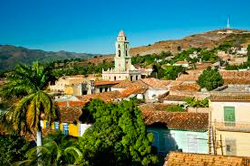 |
TrinidadTrinidad is one of the most historic cities in Cuba. The Old Town section is a UNESCO World Heritage Site, and is only accessible by foot or horseback. Trinidad was a sugar trading center in the 17th and 18th centuries. Now, tobacco and cigar production and tourism are the main industries in the city. |
| Back to Map | |
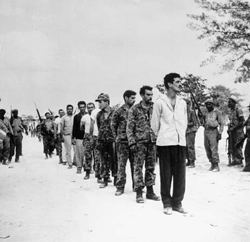 |
Bay of PigsThe Bay of Pigs was the site of the United States invasion of Cuba on April 17, 1961. In order to overthrow the Communist government led by fidel Castro, the CIA trained Cuban exiles in guerrilla warfare so they could begin a guerrilla war against Castro. President John F. Kennedy chose the Bay of Pigs for the location of the invasion because of its secluded location. The invasion however, proved a failure. The Cuban military sank the invading ships and captured the fighters on the ground. Fidel Castro remained in power, possibly stronger than before the invasion. Today, the Bay of Pigs remains an important historical site. |
| Back to Map | |
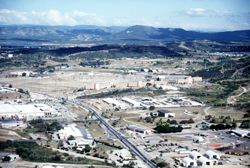 |
Guantanamo BaySince 1903, the United States has leased 45 square miles of southeastern Cuba for the naval base Guantanamo Bay. In 1934, both nations signed a perpetual lease, which allowed the United States to occupy the region indefinitely for $4,085 per year. The lease can only be terminated by mutual agreement, or if the United States abandons it. The site is home to a controversial detention center designed to punish and interrogate those suspected of committing war crimes against the United States. |
| Back to Map | |
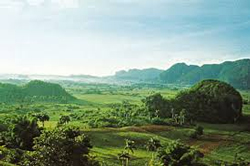 |
Viñales ValleyThe Viñales Valley is located in the western Cuba. The valley's land and climate are perfect for growing and harvesting tobacco for Cuba's famous cigar industry. The landscape of the country is notable for its mogotes, or tall, rounded hills rising from the flat valley plain. In order to preserve the landscape and the quality of tobacco, traditional techniques of harvesting are still used. The area is a UNESCO World Heritage Site. |
| Back to Map | |
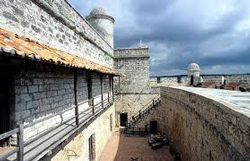 |
Castillo de JaguaThe Jagua Fortress is a fortress (or castle) south of Cienfuegos in Cuba. It was built by King Philip V of Spain in 1742, to protect the Bay of Cienfuegos from pirates. After the coastal city of Cienfuegos was built in the early 20th century, the harbor became a center of commerce for the area, and remains an essential port for the country’s economy. The limestone fortress is still in good condition, with a drawbridge still fit for use. |
| Back to Map | |
| Population: | 11,270,000 |
| Area: | 42,426 square miles |
| Capital City: | Havana |
| Largest City: | Havana |
| Currency: | Cuban Peso, Cuban Convertible Peso |
| Official Language: | Spanish |
| GDP (Gross Domestic Product) | $68 billion |
- The Republic of Cuba includes more than 4,000 islands and cays
- Cuba's main island is the largest in the West Indies
- Cuba has the highest doctor to patient ratio in the world
- In 1961, Cuba became the first Communist state in the Western Hemisphere
- In 2000, Cub an leader Fidel Castro commissioned a statue of John Lennon (lead singer of the Beatles) to be built. Castro considered Lennon a musical revolutionary.
- Before 2011, Cubans were not allowed to buy electronic appliances or cell phones, or stay in hotel
- The only cars that Cuban citizens can own are cars created and bought before 1959
- Cuba has a literacy rate of 99.8% - one of the highest in the world
- The smallest bird in the world is found in Cuba - the bee hummingbird, which grows to only 2 inches in length
- The 1962 Cuban Missile Crisis between the United States and the Soviet Union, nearly led to war between the two nations. In the crisis, Soviet forces positioned missiles in Cuba, within range of the mainland United States. |
|
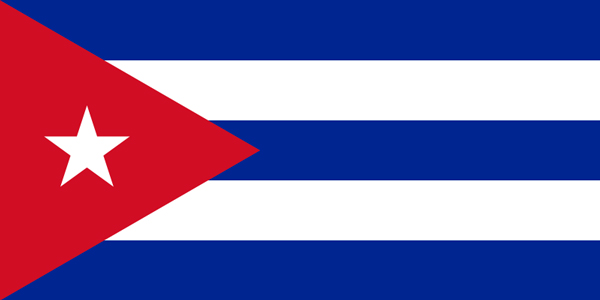 |
|
The blue stripes represent the three old divisions of the island (central, occidental, oriental); the white stripes symbolize the purity of the independence ideal. The triangle is for liberty, equality, and fraternity, and the red stands for the blood shed in the independence struggle. The white star lights the way to freedom, and was taken from the flag of Texas (and is referred to as La Estrella Solitaire - the Lone Star). |
|